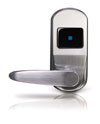
Small retail stores, offices, universities and school districts and small manufacturers need access control just as larger facilities do, but sometimes, can be limited with smaller budgets and other obstacles. In addition, these smaller enterprises need simple, easy-to-operate and easy-to-program systems that often may not require full-time administration of the system.
Unaccounted for keys and untraceable access are concerns for any size facility. Recently, these issues were faced by the Polk County Composite Squadron of the Civil Air Patrol in Florida. The group’s facility needs to be accessible by the squadron at any time of the day or night to handle search and rescue emergencies; however, the building is generally unmanned. Squadron members had been issued keys in the past, but when keys are lost, the expense of re-keying the locks must be incurred. In addition, it can be a headache to keep key assignments current as personnel changes occur.
With only two doors needing to be secured, a typical computer based card access system was too complex and exceeded the budget. The Civil Air Patrol squadron ultimately selected the EZ-Access product from Dortronics Systems. The system includes strikes installed on two doors to utilize the existing lockset hardware and to avoid special door preparation.
Jon Petersen, the local squadron commander, wanted the squad’s 30 members to have 24-hour access through the main entrance while limiting access into the secure radio room to only a few people. This was accomplished by programming all cards into a main entry reader, but only cards for authorized personnel into the radio room card reader. The facility is now secured 24 hours a day, and any time a member enters the facility using his card, a historical entry is added to the database for future reporting.
Unaccounted for keys and untraceable access are concerns for any size facility. Recently, these issues were faced by the Polk County Composite Squadron of the Civil Air Patrol in Florida. The group’s facility needs to be accessible by the squadron at any time of the day or night to handle search and rescue emergencies; however, the building is generally unmanned. Squadron members had been issued keys in the past, but when keys are lost, the expense of re-keying the locks must be incurred. In addition, it can be a headache to keep key assignments current as personnel changes occur.
With only two doors needing to be secured, a typical computer based card access system was too complex and exceeded the budget. The Civil Air Patrol squadron ultimately selected the EZ-Access product from Dortronics Systems. The system includes strikes installed on two doors to utilize the existing lockset hardware and to avoid special door preparation.
Jon Petersen, the local squadron commander, wanted the squad’s 30 members to have 24-hour access through the main entrance while limiting access into the secure radio room to only a few people. This was accomplished by programming all cards into a main entry reader, but only cards for authorized personnel into the radio room card reader. The facility is now secured 24 hours a day, and any time a member enters the facility using his card, a historical entry is added to the database for future reporting.
Small Defined
Kirk Davidson, president of Commercial Security Integration, in Austin, Tex. said that small is a relative term in small access control installations. “We define small as anything less than about 15 doors, and we separate it into two groups,” he said. “The first group is what we call beginners, who are controlling two or thee or four doors. This group has three primary objectives: getting rid of keys, establishing an audit trail of some kind and acquiring the ability to automatically schedule access to these doors.” Davidson has used RS2’s First Step System with many companies because he said it provides small access control at a low cost.
The second group in the “small” category, said Davidson, is users who need to control approximately 5-15 doors. “At this level, they want to include badging, security video, and possibly some biometric recognition,” he said. “In terms of integrating with other systems like video analytics, etc., this starts to happen at around that 15-door level. So, the whole issue of expandability or scalability is extremely important. They have to have a system that can grow with the organization.”
Davidson added that many small companies will install access control because they want to protect a server room. That point – and others – was echoed by Randy Jara, general manager, Red Rock Cabling in Irvine, Calif. “Our small users start out with some basic needs. Within the organization, they need to limit – and track – access to high-value areas like server rooms and inventory storage areas, and they want to get rid of having to manage keys. That’s what they start with, and then they move out from there.”
The second group in the “small” category, said Davidson, is users who need to control approximately 5-15 doors. “At this level, they want to include badging, security video, and possibly some biometric recognition,” he said. “In terms of integrating with other systems like video analytics, etc., this starts to happen at around that 15-door level. So, the whole issue of expandability or scalability is extremely important. They have to have a system that can grow with the organization.”
Davidson added that many small companies will install access control because they want to protect a server room. That point – and others – was echoed by Randy Jara, general manager, Red Rock Cabling in Irvine, Calif. “Our small users start out with some basic needs. Within the organization, they need to limit – and track – access to high-value areas like server rooms and inventory storage areas, and they want to get rid of having to manage keys. That’s what they start with, and then they move out from there.”
Smaller, with Room to Grow
Guy Grace, director of security and emergency planning for Littleton, Colo. Public Schools, said that in his opinion, no matter the size, “every school, every business and home need some type of security system in this day and age. Our needs were based upon protecting the users and the facilities that the community has invested in since the founding of the
community.”
One challenge Grace said he faces with the security system is that schools in his community are “major centerpieces. A typical school is in use 16 hours per day, 7 days a week. During school hours, the security system must address the needs of both the staff and students. It has to provide a reliable operation and a very user friendly interaction with the staff and students, while keeping the potential threats out.”
The district’s current security system consists of eight card reader points for a typical high school, in addition to 20 external cameras with 20-40 internal cameras. There are also 20 external sensors such as beam detectors and motion detectors for after hour’s security concerns.
A typical middle school has six card reader points, in addition to 15 external sensors, while a typical elementary school has five card reader points, in addition to 10 external sensors.
All of the school district’s security systems are integrated from the readers, motion detectors and door contacts, said Grace. For example, he said, “area cameras will come up when a door is open or other device is tripped and then go back to its assigned duty after the event.”
Before choosing the current system, Grace said he looked at how he could best protect the district’s children, staff and the community assets. And as is often the case with most small security installations, Grace said that he had to ensure that the system would grow with the school district’s needs.
“When we were looking for a system in 2002, we only had a very basic idea of what we wanted in a security system,” he said. “The infrastructure was in place by 2007. However, a good security system today must be able to grow, and as a result, we have added significantly to our security system. A security system and the practices that it brings is never finished in a school environment. Good security departments will always look for ways to improve. Money is certainly an issue, but if the system in truly integrated, then new technology should have no problem being integrated into the system as you can afford it. In that sense, you always have more than what you started with, blending the old and the new always complimenting each other,” he said.
Use of the system has resulted in property crime decreasing from 92 percent to 62 percent per school night since 2004. “Initially there was a dramatic increase of incidents when we first started,” Grace said. “That increase was only because we were now detecting things we never knew about. As the issues were addressed, incidents and crime decreased.”
He added that there used to be an average of 12 burglaries a year in the schools, in addition to major vandalism attempts. “With this security system we know when people are on our grounds. As a result, our return on investment is measureable by the vandalism and crimes that we deter versus the vandalism damage we were unable to deter or apprehend the persons responsible.”
community.”
One challenge Grace said he faces with the security system is that schools in his community are “major centerpieces. A typical school is in use 16 hours per day, 7 days a week. During school hours, the security system must address the needs of both the staff and students. It has to provide a reliable operation and a very user friendly interaction with the staff and students, while keeping the potential threats out.”
The district’s current security system consists of eight card reader points for a typical high school, in addition to 20 external cameras with 20-40 internal cameras. There are also 20 external sensors such as beam detectors and motion detectors for after hour’s security concerns.
A typical middle school has six card reader points, in addition to 15 external sensors, while a typical elementary school has five card reader points, in addition to 10 external sensors.
All of the school district’s security systems are integrated from the readers, motion detectors and door contacts, said Grace. For example, he said, “area cameras will come up when a door is open or other device is tripped and then go back to its assigned duty after the event.”
Before choosing the current system, Grace said he looked at how he could best protect the district’s children, staff and the community assets. And as is often the case with most small security installations, Grace said that he had to ensure that the system would grow with the school district’s needs.
“When we were looking for a system in 2002, we only had a very basic idea of what we wanted in a security system,” he said. “The infrastructure was in place by 2007. However, a good security system today must be able to grow, and as a result, we have added significantly to our security system. A security system and the practices that it brings is never finished in a school environment. Good security departments will always look for ways to improve. Money is certainly an issue, but if the system in truly integrated, then new technology should have no problem being integrated into the system as you can afford it. In that sense, you always have more than what you started with, blending the old and the new always complimenting each other,” he said.
Use of the system has resulted in property crime decreasing from 92 percent to 62 percent per school night since 2004. “Initially there was a dramatic increase of incidents when we first started,” Grace said. “That increase was only because we were now detecting things we never knew about. As the issues were addressed, incidents and crime decreased.”
He added that there used to be an average of 12 burglaries a year in the schools, in addition to major vandalism attempts. “With this security system we know when people are on our grounds. As a result, our return on investment is measureable by the vandalism and crimes that we deter versus the vandalism damage we were unable to deter or apprehend the persons responsible.”
Smaller is Better
A small security installation has worked for the past 11 years at San Diego State University (SDSU). The college is using 12 hand geometry readers from Ingersoll Rand Security Technologies to provide access into its six entrances at its Aztec Recreation Center, Aztec Center bowling and games facility and a racquetball court, as well as four entrances to the Aztec Aquaplex.
Instead of verifying a card or code, the readers verify the person who is at the entrance. It looks at the three-dimensional size and shape of a member’s hand. The result of 90 hand measurements, including lengths, widths, thickness and surface areas, is converted into a mathematical representation of the hand, which is stored as a template for later use and verification.
To enter the university’s facilities, a student enters an ID number on the keypad and presents her hand to gain entry. The readers are networked using a biometric software package for distributing the hand geometry templates across the network, allowing a member to enter any of the approved entrances.
“The HandKey readers minimize people’s ability to transfer IDs for admittance into our Center,” said Vicki Greene, member services coordinator for the Associated Students of SDSU. “The hand readers also allow us to provide better service. This also means we don’t need to have an employee out front checking cards. In addition, we feel that hand geometry is the least invasive of the biometric technologies and seems simple compared to the others.”
Small access installations can also work well at small manufacturing facilities, as demonstrated by Brainard Rivet Company of Girard, Ohio, a manufacturer of rivets and drilled products. The company needed increased protection for its payroll records room.
The new security system uses the Lathem LX100, a keyless/proximity badge door lock that fits standard interior doors and allows for proximity badges to be compatible between the two systems. With the system, Brainard employees can now clock and lock in or out with the same badges. Brainard management can also assign or delete employee access when needed.
Instead of verifying a card or code, the readers verify the person who is at the entrance. It looks at the three-dimensional size and shape of a member’s hand. The result of 90 hand measurements, including lengths, widths, thickness and surface areas, is converted into a mathematical representation of the hand, which is stored as a template for later use and verification.
To enter the university’s facilities, a student enters an ID number on the keypad and presents her hand to gain entry. The readers are networked using a biometric software package for distributing the hand geometry templates across the network, allowing a member to enter any of the approved entrances.
“The HandKey readers minimize people’s ability to transfer IDs for admittance into our Center,” said Vicki Greene, member services coordinator for the Associated Students of SDSU. “The hand readers also allow us to provide better service. This also means we don’t need to have an employee out front checking cards. In addition, we feel that hand geometry is the least invasive of the biometric technologies and seems simple compared to the others.”
Small access installations can also work well at small manufacturing facilities, as demonstrated by Brainard Rivet Company of Girard, Ohio, a manufacturer of rivets and drilled products. The company needed increased protection for its payroll records room.
The new security system uses the Lathem LX100, a keyless/proximity badge door lock that fits standard interior doors and allows for proximity badges to be compatible between the two systems. With the system, Brainard employees can now clock and lock in or out with the same badges. Brainard management can also assign or delete employee access when needed.


